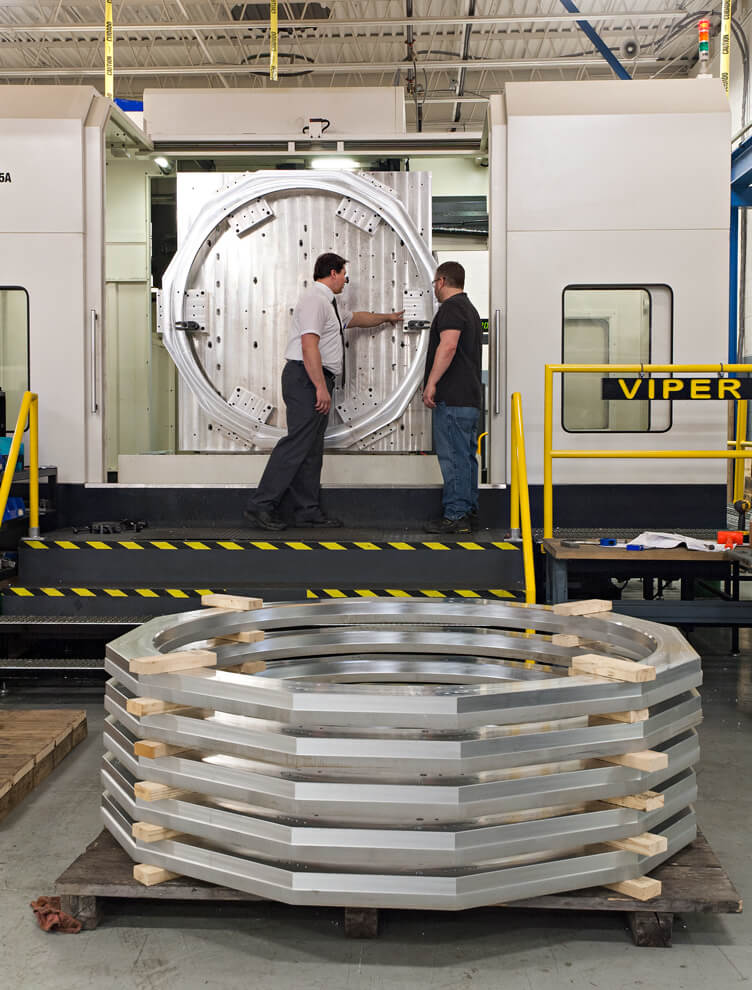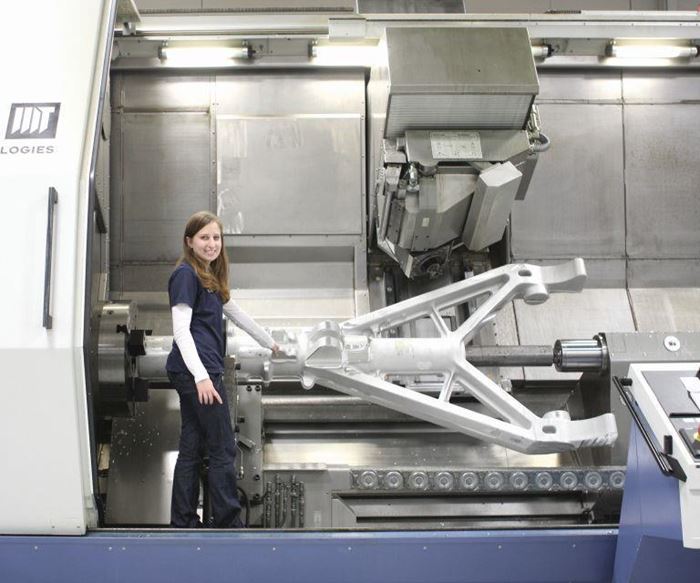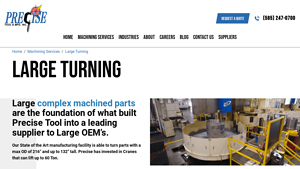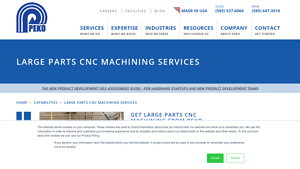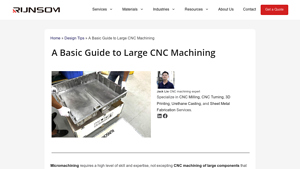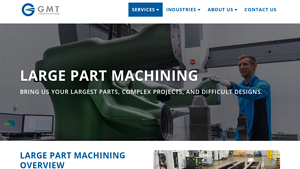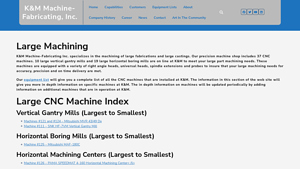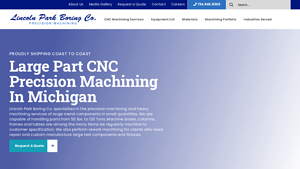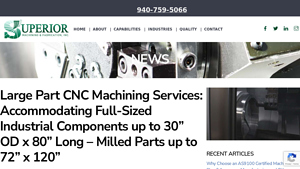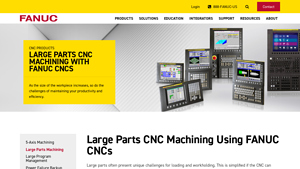Large Part Machining Guide: Type, Cost, Top List…
Introduction: Navigating the Global Market for large part machining
In the ever-evolving landscape of global manufacturing, sourcing large part machining services poses unique challenges for international B2B buyers. From navigating complex specifications to ensuring timely delivery and cost-effectiveness, the stakes are high, especially for industries reliant on precision-engineered components. This guide delves deep into the multifaceted world of large part machining, addressing critical aspects such as types of machining processes, diverse applications across various sectors, and best practices for supplier vetting.
Buyers from regions like Africa, South America, the Middle East, and Europe, including key markets like Saudi Arabia and Germany, will find actionable insights tailored to their specific needs. We will explore how to assess manufacturing capabilities, understand pricing structures, and leverage quality certifications to make informed purchasing decisions. By equipping buyers with the knowledge to navigate this complex market, this guide serves as a valuable resource, empowering them to partner with reliable suppliers who can meet stringent quality standards while delivering on time.
Whether you are looking for CNC machining, turning, or milling services, understanding the nuances of large part machining will enhance your procurement strategy and drive operational success.
Understanding large part machining Types and Variations
| Type Name | Key Distinguishing Features | Primary B2B Applications | Brief Pros & Cons for Buyers |
|---|---|---|---|
| CNC Milling | Utilizes computer-controlled machines for high precision cutting | Aerospace, automotive, heavy machinery | Pros: High precision, repeatability. Cons: Initial setup costs can be high. |
| Large Turning | Capable of machining large cylindrical parts with tight tolerances | Oil & gas, mining, manufacturing | Pros: Efficient for large parts. Cons: Limited to rotational shapes. |
| Horizontal Boring | Allows for machining large holes and complex shapes with precision | Industrial equipment, construction machinery | Pros: Versatile for various shapes. Cons: Requires significant floor space. |
| 5-Axis Machining | Offers multi-directional cutting for complex geometries | Medical devices, aerospace components | Pros: High complexity handling. Cons: More expensive due to advanced technology. |
| Fabrication Services | Includes welding, assembly, and additional machining processes | Construction, automotive, and aerospace | Pros: Comprehensive service. Cons: May lead to longer lead times. |
What Are the Key Characteristics of CNC Milling in Large Part Machining?
CNC milling is a cornerstone of large part machining, leveraging computer-controlled machines to achieve high precision and repeatability. This method excels in producing intricate components with tight tolerances, making it ideal for industries such as aerospace and automotive. When considering CNC milling, B2B buyers should evaluate the supplier’s capabilities in handling the specific materials required for their projects, as well as the setup costs associated with complex designs.
How Does Large Turning Benefit B2B Buyers?
Large turning is specialized for machining large cylindrical parts, allowing manufacturers to achieve tight tolerances efficiently. This process is particularly beneficial in sectors like oil and gas, where large components such as pipes and casings are common. Buyers should assess the supplier’s machinery capabilities, particularly the maximum diameter and height they can handle, to ensure they meet project specifications without compromising quality.
What Are the Advantages of Horizontal Boring in Large Part Machining?
Horizontal boring is characterized by its ability to create large holes and complex shapes, making it versatile for various applications, including industrial equipment and construction machinery. This method is particularly useful for components that require precise alignment and tight tolerances. B2B buyers should consider the shop’s floor space and equipment capabilities, as horizontal boring requires significant room for setup and operation.
Why Choose 5-Axis Machining for Complex Geometries?
5-axis machining allows for multi-directional cutting, making it suitable for complex geometries found in medical devices and aerospace components. This advanced technique provides the flexibility to manufacture intricate parts in a single setup, reducing lead times and improving accuracy. Buyers should weigh the higher costs associated with 5-axis machining against the potential for increased efficiency and reduced production cycles.
How Do Fabrication Services Enhance Large Part Machining Projects?
Fabrication services encompass a range of processes, including welding, assembly, and secondary machining, providing a comprehensive solution for large part projects. This approach is particularly useful in industries like construction and automotive, where multiple processes are often required for a single component. B2B buyers should consider the lead times and potential complexities involved in coordinating multiple services when selecting a supplier for fabrication services.
Key Industrial Applications of large part machining
| Industry/Sector | Specific Application of large part machining | Value/Benefit for the Business | Key Sourcing Considerations for this Application |
|---|---|---|---|
| Aerospace | Machining of aircraft engine components | Ensures high precision and reliability, critical for safety standards | Certifications (AS9100), material specifications, lead times |
| Energy | Production of turbine components | Enhances efficiency and performance in energy generation | Tolerance requirements, material types (e.g., superalloys), delivery schedules |
| Heavy Machinery | Manufacturing large frames and chassis for equipment | Improves durability and operational efficiency in harsh environments | Weight capacity, machining capabilities, post-machining services |
| Oil & Gas | Fabrication of pipeline components and valves | Supports infrastructure reliability and operational safety | Material sourcing (corrosion-resistant), compliance with industry standards |
| Marine | Production of large hull components | Enhances vessel performance and longevity | Custom design capabilities, quality control processes, environmental regulations |
How is Large Part Machining Used in Aerospace Applications?
In the aerospace sector, large part machining is crucial for producing components such as engine casings, turbine blades, and structural frames. These parts must meet rigorous safety and performance standards, requiring precision machining to tight tolerances. International buyers in this sector must consider suppliers’ certifications, such as AS9100, to ensure compliance with aerospace quality standards. Additionally, the ability to work with advanced materials and maintain reliable lead times is essential for meeting project timelines.
What Role Does Large Part Machining Play in Energy Production?
In the energy industry, large part machining is employed to manufacture components for turbines and generators, which are vital for energy efficiency. Parts like turbine blades and casings must be precisely machined to withstand extreme conditions while optimizing performance. Buyers should prioritize sourcing from manufacturers with expertise in machining superalloys and other specialized materials. Understanding the supplier’s capacity for meeting tolerance requirements and delivery schedules is also critical for maintaining operational efficiency.
How is Large Part Machining Beneficial for Heavy Machinery?
Heavy machinery relies on large part machining to create robust frames and chassis that can endure harsh operational environments. Machined components such as gearboxes, axles, and structural supports must be durable and precisely engineered to ensure operational efficiency. For international buyers, it is essential to evaluate a supplier’s machining capabilities, including their ability to handle significant weight and complex geometries. Additionally, post-machining services, such as assembly and welding, can be crucial for ensuring the integrity of the final product.
What are the Applications of Large Part Machining in Oil & Gas?
In the oil and gas industry, large part machining is utilized for the fabrication of pipeline components, valves, and pressure vessels that are integral to infrastructure reliability. These components must be manufactured from corrosion-resistant materials and adhere to strict safety regulations. Buyers should focus on suppliers who can demonstrate compliance with industry standards and provide detailed information on their material sourcing practices. Additionally, understanding the lead times and production capacity is vital for timely project execution.
How Does Large Part Machining Enhance Marine Applications?
Large part machining is essential in the marine sector for producing hull components and other structural elements of vessels. These parts must be designed for strength and durability to withstand the marine environment, which often includes exposure to saltwater and heavy loads. Buyers in the marine industry should look for manufacturers with custom design capabilities and rigorous quality control processes. Moreover, compliance with environmental regulations can influence sourcing decisions, making it crucial to choose suppliers who prioritize sustainability in their operations.
3 Common User Pain Points for ‘large part machining’ & Their Solutions
Scenario 1: Difficulty in Achieving Tighter Tolerances
The Problem: In large part machining, achieving tight tolerances can be a significant challenge, especially for parts that require precision in industries like aerospace and defense. A B2B buyer might find that despite using advanced machinery, the parts produced do not meet the specified tolerances. This issue can lead to costly delays, rework, and ultimately dissatisfaction with the supplier’s capabilities, impacting the buyer’s production schedules and overall project timelines.
The Solution: To overcome this challenge, buyers should focus on selecting machining partners that emphasize rigorous quality control processes and have a proven track record in precision machining. When sourcing a supplier, ask for case studies or examples of previous projects that required tight tolerances. Look for certifications such as ISO 9001 or AS 9100, which indicate adherence to high-quality standards. Additionally, consider working with suppliers who utilize advanced technologies such as multi-axis machining and CNC systems capable of maintaining tolerances of ±0.0005 inches. Establishing a clear communication channel with the machining partner about specific tolerance requirements and conducting periodic quality audits can also help ensure that parts meet stringent specifications.
Scenario 2: Long Lead Times and Delayed Deliveries
The Problem: Timeliness is critical in the B2B sector, particularly for companies that rely on large machined components to keep their production lines running. A buyer may encounter frustration when a machining supplier fails to deliver parts on time, leading to production downtimes and potential loss of revenue. This issue is often exacerbated by a lack of transparency in the supplier’s production schedule and unforeseen delays in the machining process.
The Solution: To mitigate long lead times, buyers should prioritize suppliers with a robust project management system that offers real-time updates on production status. When engaging with potential suppliers, inquire about their lead time commitments and request information on their production capacity and scheduling flexibility. It can be beneficial to establish a collaborative relationship, where both parties can discuss timelines and adjust as necessary. Implementing a “Red Alert” system for urgent projects can also ensure that critical components are prioritized. Additionally, maintaining a buffer stock of essential parts can help alleviate the impact of delays on overall operations.
Scenario 3: Limited Material Options and Incompatibility Issues
The Problem: Many B2B buyers face difficulties when it comes to sourcing specific materials for large part machining. The challenge is not only about the availability of materials but also about ensuring that the chosen material is compatible with the machining processes and the end-use application. This can lead to increased costs, longer lead times, and potential failures if the materials do not perform as expected in their applications.
The Solution: To address material-related challenges, buyers should collaborate closely with their machining partners from the project inception stage. Discuss the specific requirements of the end product and explore a wide range of material options available. Suppliers with extensive experience in large part machining often have access to various standard and exotic metals, enabling them to recommend the most suitable materials for specific applications. Engage in discussions about material properties, machining capabilities, and any post-processing needs (like heat treatment or surface finishing) that may affect performance. Furthermore, consider suppliers who can provide material certifications and test results to ensure compliance with industry standards. This proactive approach will facilitate smoother project execution and minimize compatibility issues.
Strategic Material Selection Guide for large part machining
What Are the Key Properties of Common Materials Used in Large Part Machining?
In the realm of large part machining, selecting the right material is crucial for ensuring optimal performance and longevity of the final product. Here, we analyze four common materials—Steel, Aluminum, Cast Iron, and Titanium—highlighting their properties, advantages, disadvantages, and specific considerations for international buyers.
Steel: The Versatile Workhorse
Steel is widely regarded for its strength and versatility, making it a popular choice for large part machining. Key properties include high tensile strength and excellent wear resistance, along with good temperature and pressure ratings. Steel’s corrosion resistance can be enhanced through galvanization or alloying with materials like chromium or nickel.
Pros: Steel is durable and cost-effective, making it suitable for a wide range of applications, from automotive to heavy machinery. Its machining complexity can vary based on the specific alloy used, but many steel types are relatively easy to machine.
Cons: While steel is robust, it can be heavy, which may complicate handling and transportation. Additionally, some steel grades may be prone to rust if not properly treated.
Impact on Application: Steel is compatible with various media, including oil and water, making it suitable for hydraulic systems and structural components.
Considerations for International Buyers: Compliance with standards such as ASTM A36 or DIN 17100 is essential. Buyers in regions like Europe and the Middle East often prefer specific grades that meet stringent quality certifications.
Aluminum: Lightweight and Corrosion-Resistant
Aluminum is favored for its lightweight and corrosion-resistant properties, making it ideal for applications where weight savings are critical, such as in aerospace and automotive industries. It has a lower temperature rating compared to steel but offers excellent machinability.
Pros: The primary advantage of aluminum is its low density, which reduces shipping costs and improves fuel efficiency in transport applications. It is also highly resistant to corrosion, making it suitable for outdoor applications.
Cons: Aluminum may not withstand high temperatures as effectively as steel and can be more expensive per pound. Additionally, it can be softer and less durable under heavy loads.
Impact on Application: Aluminum is suitable for applications involving exposure to moisture or chemicals, such as marine environments.
Considerations for International Buyers: Buyers should ensure compliance with standards like ASTM B221 and consider local preferences for specific alloys, such as 6061 or 7075, particularly in Europe and the Middle East.
Cast Iron: Strength and Damping Properties
Cast iron is known for its excellent castability and good wear resistance, making it a common choice for large components like machine bases and frames. Its key properties include high compressive strength and superior damping capabilities, which help reduce vibrations.
Pros: Cast iron is cost-effective and provides excellent machinability, especially in roughing operations. Its ability to absorb vibrations makes it ideal for precision machining applications.
Cons: Cast iron is brittle and can crack under excessive stress. It is also heavier than aluminum and may require specialized handling equipment.
Impact on Application: Suitable for heavy machinery and automotive components, cast iron performs well in high-load scenarios.
Considerations for International Buyers: Compliance with ASTM A48 or similar standards is crucial. Buyers should also consider regional preferences for specific grades, especially in markets like Germany, where precision is paramount.
Titanium: High Strength-to-Weight Ratio
Titanium is renowned for its exceptional strength-to-weight ratio and corrosion resistance, making it ideal for aerospace and medical applications. Its key properties include high fatigue strength and low thermal expansion.
Pros: Titanium’s lightweight nature and resistance to corrosion make it suitable for high-performance applications. It also maintains structural integrity at elevated temperatures.
Cons: The primary disadvantage of titanium is its high cost and the complexity of machining, which often requires specialized tools and techniques.
Impact on Application: Titanium is particularly effective in environments exposed to harsh chemicals or extreme temperatures, such as in aerospace or marine applications.
Considerations for International Buyers: Compliance with standards like ASTM F136 or ASTM B265 is essential. Buyers should also be aware of the limited availability and higher costs associated with titanium in regions like Africa and South America.
Summary Table of Material Selection for Large Part Machining
| Material | Typical Use Case for large part machining | Key Advantage | Key Disadvantage/Limitation | Relative Cost (Low/Med/High) |
|---|---|---|---|---|
| Steel | Heavy machinery, automotive components | High strength and durability | Heavy and can rust | Medium |
| Aluminum | Aerospace, automotive applications | Lightweight and corrosion-resistant | Lower temperature tolerance | High |
| Cast Iron | Machine bases, automotive components | Cost-effective and vibration-damping | Brittle and heavy | Low |
| Titanium | Aerospace, medical applications | Exceptional strength-to-weight ratio | High cost and complex machining | High |
This guide aims to provide B2B buyers with actionable insights into material selection for large part machining, ensuring informed decisions that align with their specific industry requirements and regional standards.
In-depth Look: Manufacturing Processes and Quality Assurance for large part machining
What Are the Main Stages in the Manufacturing Process for Large Part Machining?
The manufacturing process for large part machining typically involves several key stages: material preparation, forming, assembly, and finishing. Each stage plays a crucial role in ensuring that the final product meets the desired specifications and quality standards.
Material Preparation: How Is Material Readied for Large Part Machining?
Material preparation is the foundational step in the manufacturing process. It involves selecting the appropriate materials based on the specific requirements of the part. Common materials used in large part machining include steel, aluminum, stainless steel, and exotic alloys like titanium and Inconel.
Once the material is selected, it undergoes processes such as cutting, shearing, or blanking to create manageable pieces that fit the machining equipment. This initial preparation often includes surface treatments to remove impurities, ensuring a clean surface for subsequent machining processes.
Forming: What Techniques Are Used for Machining Large Parts?
The forming stage employs various machining techniques tailored to the complexity and size of the part. Common methods include:
-
CNC Turning: This technique is particularly effective for cylindrical parts. CNC lathes can handle diameters up to 216 inches and lengths exceeding 132 inches, ensuring precision and tight tolerances.
-
CNC Milling: This method is utilized for parts requiring complex geometries. Horizontal and vertical milling machines with multi-axis capabilities can accommodate large dimensions while maintaining precision.
-
Boring and Drilling: These techniques are used to create holes and internal features in large parts. Boring mills can achieve high accuracy and are essential for creating parts with precise internal dimensions.
-
Welding and Assembly: For larger assemblies, welding may be necessary to join multiple components. This process requires skilled personnel to ensure structural integrity and adherence to specifications.
Finishing: What Are the Final Steps in Large Part Machining?
The finishing stage involves refining the machined parts to achieve the required surface finish and tolerances. Techniques such as grinding, polishing, and coating may be employed to enhance the part’s durability and aesthetic appeal. Finishing processes are critical, especially for parts used in industries like aerospace and automotive, where precision is paramount.
How Is Quality Assurance Integrated into Large Part Machining?
Quality assurance (QA) is integral to the manufacturing process, ensuring that the final products meet specified standards and customer expectations. Implementing a robust QA framework involves adherence to international standards and industry-specific certifications.
What International Standards Are Relevant for Quality Assurance in Large Part Machining?
Compliance with international standards such as ISO 9001 is essential for large part machining manufacturers. ISO 9001 outlines criteria for a quality management system, ensuring consistent quality in products and services. Other relevant certifications may include:
- AS 9100D: Specific to the aerospace industry, ensuring high-quality standards for aviation components.
- API Q1: Pertinent to manufacturers in the oil and gas sector, focusing on quality assurance in petroleum-related products.
- CE Marking: Indicates compliance with European health, safety, and environmental protection standards.
What Are the Key Quality Control Checkpoints in the Manufacturing Process?
Quality control (QC) checkpoints are critical throughout the manufacturing process to catch defects early and ensure compliance with specifications. Key checkpoints typically include:
-
Incoming Quality Control (IQC): Before materials enter the production line, they are inspected for quality and compliance with specifications.
-
In-Process Quality Control (IPQC): During machining, operators conduct regular inspections to monitor tolerances and detect any deviations from quality standards.
-
Final Quality Control (FQC): After machining, the finished parts undergo a comprehensive inspection, including dimensional checks and surface finish evaluations.
What Common Testing Methods Are Used in Large Part Machining?
Testing methods vary depending on the part’s application and industry standards. Common methods include:
- Dimensional Inspection: Utilizing tools such as calipers, micrometers, and CMM (Coordinate Measuring Machines) to verify the dimensions of the part.
- Non-Destructive Testing (NDT): Techniques like ultrasonic testing, magnetic particle testing, and dye penetrant testing are employed to identify internal flaws without damaging the part.
- Material Testing: Ensuring the material properties meet specifications through tensile testing, hardness testing, and impact testing.
How Can B2B Buyers Verify Supplier Quality Control?
B2B buyers can take several steps to verify a supplier’s quality control processes:
-
Conduct Audits: Regular audits of the supplier’s facilities can provide insights into their QC processes and adherence to standards. These audits should assess both the manufacturing processes and the quality management systems in place.
-
Request Quality Reports: Suppliers should be able to provide documentation demonstrating their quality assurance practices, including inspection reports and certificates of compliance.
-
Third-Party Inspections: Engaging third-party inspection services can provide an unbiased assessment of the supplier’s quality control measures and product compliance with specifications.
What Are the Quality Control Nuances for International B2B Buyers?
International buyers, particularly from regions like Africa, South America, the Middle East, and Europe, should be aware of specific nuances when assessing QC:
-
Regulatory Compliance: Different countries may have varying regulations affecting product quality. Understanding local compliance requirements is essential for seamless importation and usage.
-
Cultural Differences: Communication styles and business practices vary across regions. Establishing clear expectations and standards in contracts can mitigate misunderstandings.
-
Certification Recognition: Not all certifications are universally recognized. Buyers should verify that the supplier’s certifications align with their specific industry requirements.
In summary, the manufacturing processes and quality assurance practices in large part machining are intricate and crucial for ensuring high-quality outcomes. By understanding these processes, B2B buyers can make informed decisions when selecting suppliers, ultimately leading to successful partnerships and superior products.
Practical Sourcing Guide: A Step-by-Step Checklist for ‘large part machining’
This guide provides a practical checklist for B2B buyers looking to procure large part machining services. By following these steps, you can ensure that your sourcing process is efficient, effective, and aligned with your specific needs.
Step 1: Define Your Technical Specifications
Establishing clear technical specifications is crucial for successful large part machining. Consider the dimensions, tolerances, materials, and complexity of the parts you require. This clarity helps suppliers understand your needs and prevents miscommunication, ensuring that the final product meets your expectations.
- Dimensions: Specify the size limits for length, width, and height.
- Tolerances: Determine acceptable tolerances that align with industry standards for your application.
Step 2: Research Potential Suppliers
Conduct thorough research to identify suppliers with expertise in large part machining. Look for companies that have a proven track record and specialize in your required materials and machining processes. This step is essential to ensure that you partner with a manufacturer capable of meeting your quality and production standards.
- Industry Focus: Check if they serve industries similar to yours.
- Experience: Look for years in business and examples of past projects.
Step 3: Evaluate Supplier Capabilities
Assess the machining capabilities of your shortlisted suppliers. This includes reviewing their equipment, technology, and capacity to handle large parts. Understanding their capabilities ensures they can meet your production requirements while maintaining precision.
- Machinery: Investigate the types of CNC machines and their working envelopes.
- Production Capacity: Ensure they can handle both prototype and high-volume runs.
Step 4: Verify Supplier Certifications
Certification is a key indicator of a supplier’s commitment to quality and compliance. Verify relevant certifications such as ISO 9001, AS 9100, or industry-specific standards. This step is vital for ensuring that the supplier adheres to rigorous quality management systems.
- Quality Assurance: Check for quality management certifications.
- Regulatory Compliance: Ensure they meet any necessary regulatory standards for your industry.
Step 5: Request Quotes and Compare Pricing
Once you have identified suitable suppliers, request detailed quotes. Compare not just the pricing but also the terms of service, lead times, and payment options. This analysis helps you understand the overall value offered by each supplier, beyond just the cost.
- Cost Breakdown: Look for transparency in pricing, including material and labor costs.
- Lead Times: Ensure that the lead times align with your project timelines.
Step 6: Assess Communication and Support
Effective communication is essential for a successful partnership. Evaluate how responsive and informative the suppliers are during the inquiry phase. Strong communication indicates that the supplier values customer relationships and will be attentive to your needs throughout the project.
- Response Times: Monitor how quickly they respond to your inquiries.
- Customer Support: Assess the availability of support during and after the project.
Step 7: Check References and Case Studies
Before finalizing your supplier choice, check their references and review case studies. This helps you gauge their reliability and performance from the perspective of previous clients. Testimonials and documented success stories can provide valuable insights into their operational capabilities.
- Client Feedback: Request references from clients in similar industries.
- Project Examples: Analyze case studies that showcase successful large part machining projects.
By following this checklist, you can streamline your sourcing process for large part machining, ensuring you select a supplier that meets your technical requirements and delivers quality products on time.
Comprehensive Cost and Pricing Analysis for large part machining Sourcing
What Are the Key Cost Components in Large Part Machining?
Understanding the cost structure of large part machining is vital for B2B buyers to make informed decisions. The primary cost components include:
-
Materials: The type of material significantly impacts costs. Common materials such as steel and aluminum are generally less expensive than exotic metals like titanium or Inconel. Prices fluctuate based on market demand and availability, particularly for international buyers who may face tariffs or shipping fees.
-
Labor: Skilled machinists are essential for high-quality outputs, especially when dealing with complex geometries and tight tolerances. Labor costs vary by region, with North American rates typically higher than those in Africa or South America. Understanding local wage structures can help in negotiating better rates.
-
Manufacturing Overhead: This includes costs related to facility maintenance, utilities, and administrative expenses. Suppliers with advanced technology may have higher overhead but can offer efficiencies that lead to lower overall costs.
-
Tooling: Tooling costs can be substantial, especially for custom projects requiring specialized equipment. Suppliers often amortize these costs over large production runs, making it crucial to discuss tooling arrangements upfront.
-
Quality Control (QC): Rigorous QC processes ensure that parts meet specifications, which can add to costs. Suppliers with certifications such as ISO 9001 or AS 9100 may charge more due to their stringent quality protocols, but they can also reduce the risk of costly rework.
-
Logistics: Shipping large parts can be expensive, especially for international transactions. Understanding Incoterms and logistics options is essential for managing these costs effectively.
-
Margin: Suppliers will include a profit margin in their pricing, which can vary widely based on the supplier’s market position, capabilities, and the competitive landscape.
How Do Price Influencers Affect Large Part Machining Costs?
Several factors influence the pricing of large part machining:
-
Volume/MOQ: Minimum order quantities (MOQs) can significantly affect pricing. Larger orders often lead to lower per-unit costs due to economies of scale. Buyers should consider their production needs and negotiate MOQs accordingly.
-
Specifications and Customization: Highly customized parts or those requiring unique specifications can increase costs due to the additional time and resources needed for production. Providing detailed specifications upfront can help avoid unexpected costs later.
-
Material Selection: As mentioned earlier, the choice of material can greatly influence costs. Buyers should evaluate the material’s performance requirements against its price to ensure cost-effectiveness.
-
Quality and Certifications: Parts that require higher quality standards or certifications will typically cost more. Buyers should balance the need for certifications against the potential for increased costs.
-
Supplier Factors: The supplier’s reputation, capabilities, and location can affect pricing. Established suppliers may charge a premium for their expertise but can provide reliability and quality assurance.
-
Incoterms: The terms of shipping and delivery can also impact overall costs. Understanding whether costs are included in the quoted price or will be added later is essential for budgeting.
What Tips Can Help Buyers Negotiate Better Pricing?
B2B buyers can employ several strategies to enhance their negotiating position:
-
Conduct Thorough Research: Understanding market prices for materials and labor in the supplier’s region can provide leverage during negotiations. Use this data to benchmark offers and highlight any discrepancies.
-
Consider Total Cost of Ownership (TCO): Evaluate the long-term costs associated with the parts, including maintenance, failure rates, and potential rework. A slightly higher upfront price may result in lower TCO if the quality is significantly better.
-
Build Relationships: Establishing long-term relationships with suppliers can lead to better pricing, priority service, and potential discounts on future orders.
-
Leverage Volume: If possible, consolidate orders to achieve economies of scale. Suppliers are often more willing to negotiate pricing for larger, committed contracts.
-
Be Clear on Specifications: Providing detailed, clear specifications upfront can prevent misunderstandings and help suppliers provide accurate quotes, reducing the likelihood of cost overruns.
Conclusion
While the landscape of large part machining can be complex, understanding the cost components, price influencers, and negotiation strategies will empower international B2B buyers to make informed sourcing decisions. Always remember to request indicative prices and be aware that actual costs may vary based on specific project requirements and market conditions.
Alternatives Analysis: Comparing large part machining With Other Solutions
Understanding Alternative Solutions for Large Part Machining
In the realm of manufacturing, large part machining is a critical process for producing oversized components with precision. However, businesses often explore alternative solutions that might better fit their specific needs, budget constraints, or operational capabilities. This section will compare large part machining with two viable alternatives: additive manufacturing (3D printing) and traditional fabrication methods (like welding and assembly).
Comparison Table
| Comparison Aspect | Large Part Machining | Additive Manufacturing (3D Printing) | Traditional Fabrication Methods |
|---|---|---|---|
| Performance | High precision and tight tolerances; suitable for complex geometries. | Excellent for rapid prototyping; limited to certain materials and geometries. | Good for simple parts; may lack precision for complex designs. |
| Cost | Higher initial setup cost; cost-effective for large production runs. | Lower setup costs; cost-effective for small batches, but material costs can be high. | Generally lower initial costs; labor-intensive and can vary based on complexity. |
| Ease of Implementation | Requires specialized equipment and skilled labor; longer lead times. | Relatively easy to implement; requires less specialized labor. | Straightforward for skilled workers; longer setup time for complex projects. |
| Maintenance | Requires regular maintenance of CNC machines; downtime can be costly. | Minimal maintenance needed; technology is continuously evolving. | Requires maintenance of welding and assembly equipment; can be labor-intensive. |
| Best Use Case | Ideal for large, precision components in aerospace, automotive, and heavy machinery. | Best suited for prototyping and low-volume production of complex parts. | Effective for large assemblies and structures, particularly in construction and fabrication. |
In-Depth Analysis of Alternatives
Additive Manufacturing (3D Printing)
Additive manufacturing offers a unique approach to producing parts by building them layer by layer from digital models. This method excels in rapid prototyping and is particularly beneficial for creating complex geometries that would be challenging or impossible with traditional machining. However, it often faces limitations regarding material options and may not achieve the same level of precision or surface finish as large part machining. While initial costs are lower, the expense of high-quality materials can add up, making it less cost-effective for large production runs.
Traditional Fabrication Methods
Traditional fabrication encompasses a variety of processes, including welding, cutting, and assembly. This approach is generally cost-effective for creating large structures and can be particularly beneficial in industries like construction and heavy equipment manufacturing. However, it may not offer the precision required for complex components, and the labor-intensive nature of these methods can lead to longer lead times. While traditional fabrication can be a viable alternative for straightforward projects, it may fall short in scenarios demanding high precision and intricate designs.
Conclusion: How to Choose the Right Solution for Your Needs
When deciding between large part machining and its alternatives, B2B buyers should carefully evaluate their specific project requirements, including desired precision, production volume, and material considerations. Large part machining stands out for its ability to produce highly precise components in large quantities, making it ideal for industries with stringent tolerances. On the other hand, additive manufacturing may be more suitable for projects focused on rapid prototyping or complex shapes, while traditional fabrication might serve well for simpler, larger structures. By aligning these factors with the operational capabilities and strategic goals of their business, buyers can make informed decisions that enhance efficiency and effectiveness in their manufacturing processes.
Essential Technical Properties and Trade Terminology for large part machining
What Are the Essential Technical Properties in Large Part Machining?
When engaging in large part machining, understanding key technical specifications is crucial for ensuring quality and precision in production. Here are some critical specifications and their significance in the B2B context:
-
Material Grade
Material grade refers to the specific type of material used in manufacturing parts, such as steel, aluminum, or exotic alloys. The choice of material impacts durability, weight, and resistance to environmental factors. For B2B buyers, selecting the appropriate material grade is vital to meet application-specific requirements and regulatory standards, ensuring the longevity and performance of the final product. -
Tolerance
Tolerance defines the permissible limit of variation in a part’s dimensions. It is typically expressed as a range (e.g., ±0.001 inches). In large part machining, maintaining tight tolerances is critical for components that must fit precisely within assemblies. For B2B buyers, understanding tolerance requirements helps in selecting the right machining partner capable of meeting their specifications, thereby reducing the risk of costly rework or product failures. -
Surface Finish
Surface finish refers to the texture and smoothness of a machined part’s surface, often described by Ra (Roughness Average) values. A finer finish may be necessary for components that require minimal friction or enhanced aesthetic appeal. For buyers, specifying the required surface finish can affect both the functionality and visual quality of the final product, impacting customer satisfaction and market competitiveness. -
Dimensional Stability
Dimensional stability indicates a material’s ability to maintain its shape and size under varying environmental conditions. This property is particularly important for large parts exposed to temperature fluctuations or humidity. For B2B buyers, ensuring that the machining process considers dimensional stability can lead to improved performance and reduced warranty claims. -
Machining Time
Machining time is the total duration required to produce a part, influenced by factors like complexity, material type, and machine capabilities. Understanding machining time helps buyers manage project timelines and costs effectively. By selecting a supplier with optimized machining processes, buyers can ensure timely delivery, which is crucial for maintaining production schedules.
What Trade Terminology Should B2B Buyers Know for Large Part Machining?
Familiarity with industry jargon is essential for effective communication and negotiation. Here are some common terms used in large part machining:
-
OEM (Original Equipment Manufacturer)
An OEM is a company that produces parts or equipment that may be marketed by another manufacturer. Understanding the role of OEMs is crucial for buyers seeking reliable suppliers for high-quality components that fit specific applications. -
MOQ (Minimum Order Quantity)
MOQ refers to the smallest quantity of a product that a supplier is willing to sell. This term is significant for B2B buyers as it affects purchasing decisions and inventory management. Understanding MOQs can help buyers negotiate better terms or explore alternative suppliers if their needs are smaller than the stated minimum. -
RFQ (Request for Quote)
An RFQ is a document that buyers send to suppliers to request pricing for specific products or services. It outlines the specifications and quantities needed. For B2B buyers, crafting a detailed RFQ ensures they receive accurate and competitive quotes, streamlining the procurement process. -
Incoterms (International Commercial Terms)
Incoterms are a set of standardized trade terms that define the responsibilities of buyers and sellers in international transactions. Familiarity with Incoterms helps buyers understand shipping costs, risk transfer, and delivery obligations, which is essential for managing logistics in global supply chains. -
CNC (Computer Numerical Control)
CNC refers to the automated control of machining tools via computer programming. This technology is fundamental in large part machining, allowing for high precision and repeatability. For buyers, understanding CNC capabilities can inform their decisions regarding the complexity and quality of the parts produced.
By grasping these essential technical properties and industry terms, B2B buyers can navigate the landscape of large part machining more effectively, ensuring they make informed decisions that align with their operational needs and strategic goals.
Navigating Market Dynamics and Sourcing Trends in the large part machining Sector
What Are the Current Market Dynamics and Key Trends in Large Part Machining?
The large part machining sector is experiencing significant growth, driven by a surge in demand across various industries, including aerospace, defense, automotive, and heavy machinery. Global trends indicate an increasing reliance on precision engineering, with manufacturers seeking partners that can deliver tight tolerances and complex geometries. This demand is compounded by the rise of automation and Industry 4.0 technologies, which enhance production efficiency and reduce lead times. International B2B buyers, particularly from regions like Africa, South America, the Middle East, and Europe, are increasingly looking for suppliers who can provide not only high-quality machining services but also flexible manufacturing capabilities to accommodate bespoke requirements.
Emerging technologies, such as advanced CNC machining, additive manufacturing, and artificial intelligence, are revolutionizing the sector. These innovations enable manufacturers to produce intricate designs with minimal waste and improved accuracy. Additionally, the trend towards digitalization allows for real-time monitoring of production processes, which enhances quality control and operational transparency. Buyers should be aware of these advancements when sourcing partners, as they directly influence production capabilities and overall cost-effectiveness.
Furthermore, geopolitical factors and supply chain disruptions are prompting buyers to diversify their sourcing strategies. Companies are increasingly seeking suppliers in multiple regions to mitigate risks associated with reliance on a single market. As a result, the ability to provide competitive pricing and reliable service is becoming paramount for suppliers looking to establish a foothold in this dynamic market.
How Is Sustainability and Ethical Sourcing Influencing Large Part Machining?
As environmental awareness grows, sustainability and ethical sourcing are becoming crucial considerations for B2B buyers in the large part machining sector. Companies are increasingly scrutinizing their supply chains to ensure they align with sustainability goals, focusing on reducing carbon footprints and minimizing waste. This shift is particularly relevant for international buyers from Africa, South America, and the Middle East, where environmental regulations are tightening and consumer demand for sustainable practices is on the rise.
Suppliers are responding to these demands by adopting green certifications and utilizing eco-friendly materials in their machining processes. Buyers should prioritize partnerships with manufacturers who demonstrate a commitment to sustainability, such as those using recycled metals or environmentally friendly lubricants. Additionally, companies that implement energy-efficient machinery and practices are more likely to gain a competitive edge, appealing to eco-conscious clients.
The emphasis on ethical sourcing also extends to labor practices, where buyers are increasingly interested in ensuring that their suppliers adhere to fair labor standards. This aspect not only enhances corporate social responsibility (CSR) but also builds trust and loyalty with end consumers. As sustainability becomes a cornerstone of business strategy, buyers in the large part machining sector should actively seek suppliers that prioritize ethical practices and environmental stewardship.
What Is the Historical Evolution of Large Part Machining?
The evolution of large part machining has been marked by significant technological advancements and shifts in market demands. Initially, machining processes were labor-intensive, relying heavily on manual techniques. The introduction of CNC (Computer Numerical Control) machining in the late 20th century revolutionized the industry, allowing for higher precision and repeatability. As industries evolved, so did the machinery; modern CNC machines now boast multi-axis capabilities and advanced software, enabling the production of complex components with greater efficiency.
Over the years, the sector has also seen an increase in specialization, with companies focusing on specific industries such as aerospace or energy. This specialization has led to the development of tailored solutions that meet the unique requirements of each sector, thereby enhancing the overall value proposition for B2B buyers. Today, large part machining continues to advance, driven by innovations in automation, materials science, and digital technologies, positioning it as a critical component of modern manufacturing ecosystems.
Frequently Asked Questions (FAQs) for B2B Buyers of large part machining
-
How do I ensure the quality of large part machining suppliers?
To ensure quality, start by verifying the supplier’s certifications such as ISO 9001 or AS 9100, which indicate adherence to quality management standards. Request samples of their previous work to assess precision and finish. Additionally, inquire about their quality control processes, including inspection methods and equipment used. Engaging in a site visit, if possible, can provide deeper insight into their operations and capabilities. Finally, consider customer reviews and testimonials to gauge reliability and service quality. -
What is the best way to communicate my requirements for large part machining?
Clearly communicate your specifications through detailed technical drawings and documentation. Include information on dimensions, tolerances, materials, and any finishing requirements. Utilize 3D models if possible, as they can provide a comprehensive view of your needs. Schedule a preliminary discussion with the supplier to address any questions they may have, ensuring both parties have a mutual understanding. Regular updates throughout the machining process can also help avoid miscommunication. -
What are the common materials used in large part machining?
Large part machining typically involves a variety of materials, including steel, stainless steel, aluminum, cast iron, and exotic alloys like Inconel or Hastelloy. The choice of material depends on the application and performance requirements, such as strength, weight, and corrosion resistance. Discussing material options with your supplier can help you select the most suitable one for your project. They may also provide guidance on material availability and cost implications. -
What minimum order quantities (MOQs) should I expect for large part machining?
Minimum order quantities can vary significantly among suppliers based on their capabilities, production capacity, and the complexity of the parts. Some suppliers may accommodate low-volume projects, while others may require higher MOQs to justify setup costs. It’s essential to discuss your specific needs with potential suppliers to determine their flexibility regarding MOQs. Many manufacturers are open to negotiation, especially for long-term partnerships. -
What payment terms are standard for international B2B machining contracts?
Payment terms can vary widely based on the supplier’s policies, the size of the order, and the buyer’s creditworthiness. Common terms include upfront deposits (often 30-50%), with the balance due upon completion or before shipping. For larger contracts, suppliers may offer payment milestones based on project progress. Consider utilizing letters of credit or escrow services to safeguard transactions, especially in international deals, to mitigate risks associated with cross-border payments. -
How do I manage logistics for shipping large machined parts internationally?
Managing logistics for large machined parts involves careful planning and coordination. Start by discussing shipping options with your supplier, who may have established relationships with freight forwarders. Ensure that your supplier packages the parts appropriately to prevent damage during transit. Be aware of customs regulations in your country and any additional fees associated with importing large goods. It’s also wise to consider insurance for high-value items to protect against potential losses. -
What are the key factors to consider when vetting a large part machining supplier?
When vetting suppliers, consider their industry experience, technological capabilities, and past performance with similar projects. Evaluate their facility’s equipment and technology to ensure they can meet your specifications. Additionally, assess their financial stability and production capacity to handle your order volume. Customer service and responsiveness are also critical factors, as they impact communication and support throughout the project. -
Can I customize my large part machining order, and how does that affect costs?
Yes, customization is often available for large part machining orders. You can specify dimensions, tolerances, materials, and finishing processes based on your project requirements. However, customization may affect costs due to increased production complexity, longer lead times, and potential tooling changes. It’s essential to discuss your customization needs with the supplier upfront to understand the implications on pricing and timelines, allowing for better budget and schedule planning.
Important Disclaimer & Terms of Use
⚠️ Important Disclaimer
The information provided in this guide, including content regarding manufacturers, technical specifications, and market analysis, is for informational and educational purposes only. It does not constitute professional procurement advice, financial advice, or legal advice.
While we have made every effort to ensure the accuracy and timeliness of the information, we are not responsible for any errors, omissions, or outdated information. Market conditions, company details, and technical standards are subject to change.
B2B buyers must conduct their own independent and thorough due diligence before making any purchasing decisions. This includes contacting suppliers directly, verifying certifications, requesting samples, and seeking professional consultation. The risk of relying on any information in this guide is borne solely by the reader.
Top 9 Large Part Machining Manufacturers & Suppliers List
1. Precise Tool – Large Turning Services
Domain: precisetool.com
Registered: 1998 (27 years)
Introduction: Large Turning services at Precise Tool & Manufacturing include machining large complex parts with a maximum outer diameter (OD) of 216 inches and a height of up to 132 inches. The facility is equipped with cranes that can lift up to 60 tons. Key offerings include cost competitiveness, tight tolerances, accurate lead times (with Red Alert options), and both prototype and production runs. Commonly m…
2. PEKO Precision – Large Parts CNC Machining
Domain: pekoprecision.com
Registered: 1998 (27 years)
Introduction: Large Parts CNC Machining Services at PEKO Precision Products include the capability to manufacture tight tolerance parts exceeding 161″ in length. The facility features a wide range of machines with work envelopes over 40″, including CNC vertical milling centers, boring mills, and large multi-axis pallet changing horizontal machines. PEKO operates 29 machines and emphasizes post-machining on crit…
3. Trace-A-Matic – High-Quality Machining Solutions
Domain: traceamatic.com
Registered: 1998 (27 years)
Introduction: Trace-A-Matic is a Tier 1 | Tier 2 supplier specializing in high-quality prototypes and large-scale part machining for OEMs across various industries. They offer cost-effective machining of large components from standard and exotic metals with complex geometries, adhering to demanding tolerances. Key details include:
– **Large CNC Machined Parts**: rings, large shafts, levers, axles, industrial r…
4. Runsom – Large Part CNC Machining
Domain: runsom.com
Registered: 2011 (14 years)
Introduction: Large part CNC machining is a manufacturing process using computer-controlled equipment to cut, shape, or form large pieces of materials into precise shapes. It is used for producing large metal parts that are too complex for traditional machining. Applications include aerospace (aircraft fuselages, wing components), military (armored vehicles, naval vessels), energy (wind turbine blades), transpo…
5. GMT Corporation – Large Part Machining Services
Domain: gmtcorporation.com
Registered: 1997 (28 years)
Introduction: Large Part Machining services for very large iron and steel components. Facility designed for cellular manufacturing with high precision and efficiency. Key features include: 50,000 sq. ft. climate-controlled space, cranes with a capacity of 20 tons, expandable to 200,000 sq. ft., and an on-site rail spur. Equipped with advanced technology such as Coordinate Measuring Machine (CMM), Leitz PMM-G CM…
6. K&M Machine-Fabricating – Large CNC Machining Solutions
Domain: k-mm.com
Registered: 2000 (25 years)
Introduction: K&M Machine-Fabricating, Inc. specializes in large CNC machining with 37 CNC machines including 10 large vertical gantry mills and 19 large horizontal boring mills. Key machines include:
– Mitsubishi MVR 43/49 Dx Vertical Gantry Mills (Machines #121 and #124) with the following specifications:
– Pallet Size: 3,500 MM x 8,000 MM
– X Axis Travel: 9,000 MM
– Y Axis Travel: 4,900 MM
– Z Axis …
7. Lincoln Park Boring Co. – CNC Precision Machining
Domain: lincolnparkboring.com
Registered: 1999 (26 years)
Introduction: Lincoln Park Boring Co. specializes in large part CNC precision machining and heavy machining services for large metal components in small quantities, capable of handling parts from 50 lbs. to 120 Tons. Services include large part vertical machining, horizontal machining, jig bore machining, CNC vertical turning lathe, Blanchard grinding, and 3-axis machining. They work with materials such as carb…
8. Superior Machining – Large Part CNC Services
Domain: superior-machining.net
Registered: 2004 (21 years)
Introduction: Large Part CNC Machining Services: Accommodating full-sized industrial components up to 30″ OD x 80″ Long; Milled parts up to 72″ in width x 120″ in length. Specializes in custom CNC milling and turning for large parts. Facility integrates multiple large-turn capacity lathes with milling capability. Over 100 CNC workcenters available. Established in 1995 with over 25 years of experience in manufac…
9. FANUC – Large Parts CNC Machining Solutions
Domain: fanucamerica.com
Registered: 1998 (27 years)
Introduction: Large Parts CNC Machining with FANUC CNCs offers solutions for the unique challenges of machining large workpieces. Key features include: 5-Axis Machining, Large Program Management, Power Failure Backup, and Straightness Compensation. FANUC CNCs provide methods for adjusting part programs to match actual part orientation, including 2D and 3D Workpiece Coordinate Rotation and Tilted Working Plane. …
Strategic Sourcing Conclusion and Outlook for large part machining
In the competitive landscape of large part machining, strategic sourcing emerges as a critical driver of operational success. By partnering with manufacturers equipped with advanced CNC technologies and a diverse machinery fleet, buyers can ensure access to high-quality, precision-engineered components. The ability to handle oversized production while adhering to strict tolerances not only enhances product reliability but also fosters long-term supplier relationships, which are essential in today’s global market.
International buyers from regions such as Africa, South America, the Middle East, and Europe should prioritize suppliers who demonstrate a commitment to innovation and quality management. Engaging with manufacturers that offer comprehensive services—from prototyping to post-machining assembly—can significantly streamline the procurement process and reduce lead times.
Looking ahead, the demand for large part machining will continue to grow, driven by advancements in technology and the increasing complexity of industrial applications. As you explore your sourcing options, consider the value of collaboration with experienced partners who can adapt to your evolving needs. Take action now to secure a competitive advantage in your industry by investing in strategic sourcing that aligns with your business objectives.
